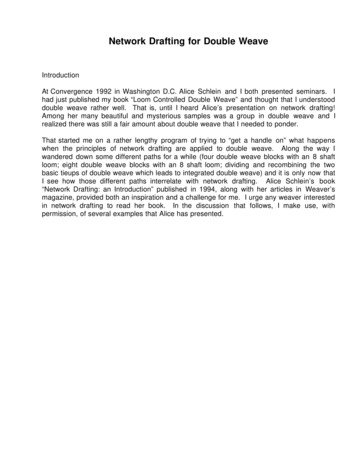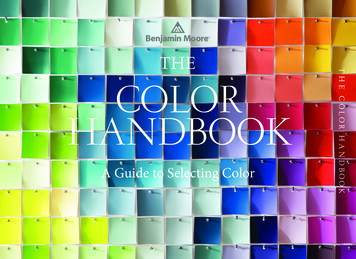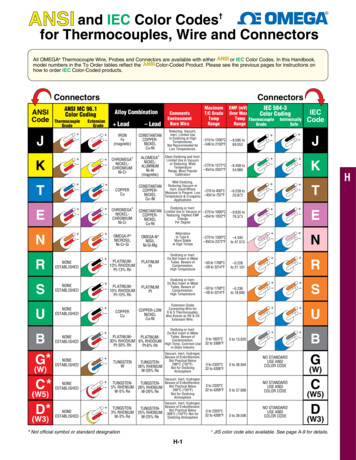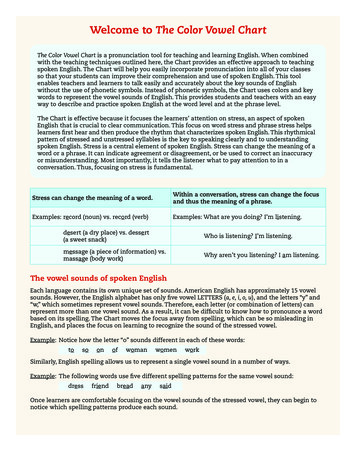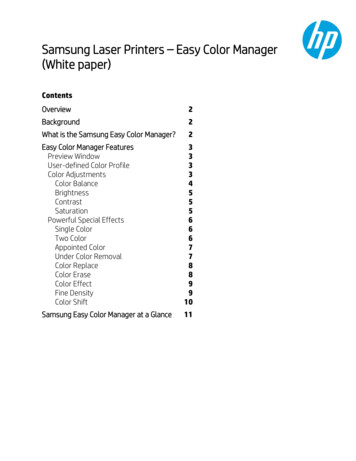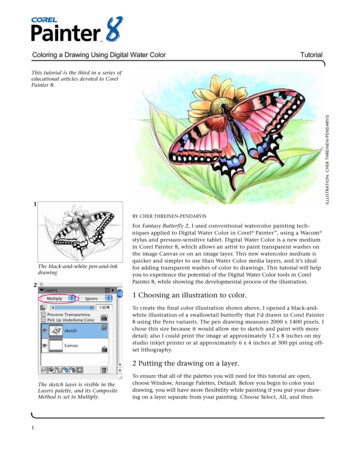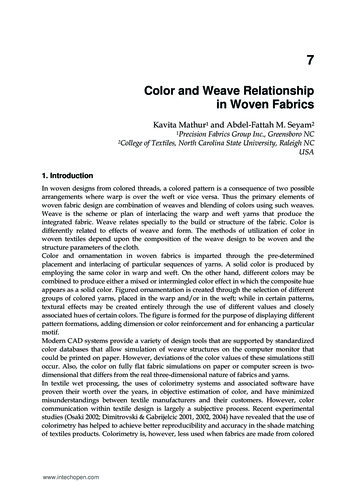
Transcription
7Color and Weave Relationshipin Woven FabricsKavita Mathur1 and Abdel-Fattah M. Seyam21Precision2CollegeFabrics Group Inc., Greensboro NCof Textiles, North Carolina State University, Raleigh NCUSA1. IntroductionIn woven designs from colored threads, a colored pattern is a consequence of two possiblearrangements where warp is over the weft or vice versa. Thus the primary elements ofwoven fabric design are combination of weaves and blending of colors using such weaves.Weave is the scheme or plan of interlacing the warp and weft yarns that produce theintegrated fabric. Weave relates specially to the build or structure of the fabric. Color isdifferently related to effects of weave and form. The methods of utilization of color inwoven textiles depend upon the composition of the weave design to be woven and thestructure parameters of the cloth.Color and ornamentation in woven fabrics is imparted through the pre-determinedplacement and interlacing of particular sequences of yarns. A solid color is produced byemploying the same color in warp and weft. On the other hand, different colors may becombined to produce either a mixed or intermingled color effect in which the composite hueappears as a solid color. Figured ornamentation is created through the selection of differentgroups of colored yarns, placed in the warp and/or in the weft; while in certain patterns,textural effects may be created entirely through the use of different values and closelyassociated hues of certain colors. The figure is formed for the purpose of displaying differentpattern formations, adding dimension or color reinforcement and for enhancing a particularmotif.Modern CAD systems provide a variety of design tools that are supported by standardizedcolor databases that allow simulation of weave structures on the computer monitor thatcould be printed on paper. However, deviations of the color values of these simulations stilloccur. Also, the color on fully flat fabric simulations on paper or computer screen is twodimensional that differs from the real three-dimensional nature of fabrics and yarns.In textile wet processing, the uses of colorimetry systems and associated software haveproven their worth over the years, in objective estimation of color, and have minimizedmisunderstandings between textile manufacturers and their customers. However, colorcommunication within textile design is largely a subjective process. Recent experimentalstudies (Osaki 2002; Dimitrovski & Gabrijelcic 2001, 2002, 2004) have revealed that the use ofcolorimetry has helped to achieve better reproducibility and accuracy in the shade matchingof textiles products. Colorimetry is, however, less used when fabrics are made from coloredwww.intechopen.com
130Advances in Modern Woven Fabrics Technologyyarns than when yarns and fabrics are dyed to a solid color, or are printed. Recent researchwork (Mathur et. al. 2005, 2008, 2009 and 2011) provided a model that involves colorimetryfor color prediction and is discussed briefly in section 4.Several measuring and imaging systems are now available commercially that can recordcolorimetric data and convert these data into visual images. Hence, the designer cangenerate a numerical color specification that can be visualized accurately on a suitablycalibrated monitor. Recent advances in color curve generation and image processingprovide opportunities for additional improvements in the areas of collaborative colordevelopment, color marketing, and color prediction in multi-step processes. Contemporarytechniques of computer-aided fabric design offer new possibilities for using colorimetry inweaving practice.Along with the fundamental description of weave and color relationship, and recentadvances in woven fabric design, this chapter also includes the research models developedto quantify the color proportion and color values, in effort to eliminate the expensive andtime consuming process of prototyping and color matching in woven fabric design.2. Woven fabric design and structureThis section introduces the reader to the basic knowledge of woven fabrics design andstructure and the concept on how colored patterns are created using colored yarns. It setsthe stage for the next sections that deal with objective evaluation of color in wovenstructures.Woven fabrics are formed by interlacing two orthogonal sets of yarns; warp yarns that arevertically arranged and weft yarns that are horizontally placed. While all weave structuresare created from a binary system (that is a warp yarn is over or under a weft yarn at thecrossover areas), infinite number of weaves can be formed. The distribution of interlacementis known as weave design or pattern. There are three types of weaves that are known asbasic weaves, which include plain weave (the simplest and smallest repeat size possible; 2warp yarns x 2 weft yarns) and its derivatives, twill weaves and their derivatives, andsatin/sateen weaves and their derivatives. These basic weaves are characterized by theirsimplicity, small size, ease of formation, and recognition. However, they form the base forcreating any complex/intricate structures (such as multi-layer fabrics and pile weavestructures) and weaves with extremely large patterns that are known as Jacquard designs.Figures 1-3 show examples of basic weaves. More on the rules to construct basic weaves andtheir derivatives can be found in Seyam 2001.WeftYarnsWarp Ends(a) Flat viewFig. 1. Plain weavewww.intechopen.com(b) Weave design
131Color and Weave Relationship in Woven Fabrics(a) Flat view(b) Weave designFig. 2. Example of twill weave (2x2 Right Hand Twill weave)(a) Flat view(b) Weave designFig. 3. Example of sateen weave (5-Harness Sateen Weave)Figures 1-3 depict two methods of presenting weaves namely flat view and weave design.While the flat view presentation provides better understanding in regards to the warp andfilling yarn interlacing, it takes time to draw especially for large size repeats. The weavedesign presentation was created to communicate in a much simpler and easy to draw weaveillustration using weave design paper (squared paper). In the weave design presentation thespaces between yarns are eliminated and only the squares where warp yarns are over theweft yarns are shown, which is reasonable since in most of woven fabrics the yarns covermost of the fabric surface. Any color or marks (such X, /, or \, etc.) can be used to indicatewhere a warp yarn is over a weft yarn. The squares that are left blank indicate otherwise.2.1 Color/weave relationshipFigure 4 shows another illustration of the weaves of Figure 1-3. In Figure 4 all the squares ofthe weave design presentations are painted using the color of warp and weft yarns (red andblue). This is known as color effect presentation. It should be pointed out that a square in thewww.intechopen.com
132Advances in Modern Woven Fabrics Technologydesign paper represents extremely small size area in the woven cloth. The colors of Figure 4will be perceived by human eye as a mixture of two colors with different ratios.(a)(b)(c)Fig. 4. Color effectsFig. 5. Color simulation of the plain weave of Figure 1Fig. 6. Color simulation of the sateen weave of Figure 3Thus, the use of colored warp and weft yarns combined with the weave structures permit thedevelopment of striking patterns. For a given pattern with multi-color, a color can bestrategically placed in the pattern by merely using the binary system of warp and weftinterlacing. The desired color of a yarn appears when the yarn is over the crossing yarns for adesired length and small or large area if several yarns are used. Moreover, numerous mixturesof colors to produce other colors can be obtained from few colors of the warp and weft yarnsthrough proper weave interlacing. Figures 5 and 6 are two examples of such mixtures. Theywere produced using many repeats in warp and weft directions, thread count close to realcloth, and assuming there are no spaces between the yarns, which is reasonable assumptionwww.intechopen.com
Color and Weave Relationship in Woven Fabrics133for most woven fabrics. Figure 5 is the color simulation produced from red warp yarns andblue weft yarns and plain weave of Figure 4(a). While the color simulation of Figure 5 isproduced from red warp yarns and blue weft yarns woven in sateen of Figure 4(c). These twoexamples indicate that numerous purple colors can be produced from only two colors (red andblue). Using this concept striking patterns can be created using few colors in warp and weftdirections such as the Jacquard design of Figure 7.Pattern is courtesy of Manual Woodworkers and Weavers, Hendersonville, N.C., USAFig. 7. Color simulation of Jacquard faric2.2 CAD and woven fabric designDesigning fabrics is a creative/technical process that is dependent upon the ability of thetextile designer to combine aesthetic sensibility with a strong knowledge of the technologyof materials and fabric production machinery. Most Dobby and Jacquard fabrics producers’facilities are now equipped with Computer Aided Textile Design systems. In the precomputer era, the designing process was done in the following manner: (a) a piece ofartwork was created on paper, (b) the artwork was then rendered as a scaled grid (known assquared paper or design paper), whose columns and rows represented warp and weft yarns,respectively, (c) weaves were then assigned to specific areas to represent the originalpattern, and (d) a technician then punched cards, direct from this technical design layout, inwhich each card represent one pick of the actual fabric.Computers have been utilized in woven textile design for almost 25 years, and this hasrevolutionized the entire design process. They have revolutionized the entire thoughtprocess from the initial artwork to final production. CAD systems in woven designingoperate in a series of basic steps. The first step is that of digitizing the artwork. This featureallows the designer to see the artwork on a computer monitor by scanning the original pieceor creating a design using the CAD system drawing tools directly. This is generally done in8-bit format (256 colors) and allows the designer to modify patterns and reduce the numberof colors to a manageable number as he/she wishes. The second step is fabric designing, inwhich the artwork image data is transformed (i.e. the grid system, above) into weavingwww.intechopen.com
134Advances in Modern Woven Fabrics Technologyinformation for fabric production. Weave allocation is the third step, in which informationfrom the artwork image can be converted into a woven fabric. The designer created theappropriate weave structure or chooses one (from a weave library) to match the desiredcolor, shape or texture in the artwork. This part of the program also helps the designer to seea simulation of the final fabric on the display monitor. By looking at the preview, thedesigner can easily modify the design, and can change the weaves to recolor the design asrequired. All these developments have greatly increased the ease of woven fabric designing.It is now possible to perform the entire process on a personal computer, and then transferthe ready-to-weave file (electronic punch-card file) via the internet, direct to the dobby orJacquard controller at the loom, or to some interim storage area.Textile CAD/CAM systems are mainly modular in structure and, in addition to coveringyarn and fabric design may also include very realistic 3D simulation packages. A completeautomated process with immediate response to the customer’s demand seems to be a realityin the near future with these systems (Dolezal & Mateja 1995; Bojic 1999; Dimitrovski & Bojic1999). Moreover, developments of powerful modem systems and electronic controls havebrought the weaving machine into the design studio. This evolution has, in turn, given anentirely new meaning to the term Quick Response.The impetus for use of CAD in the textile industry was to improve efficiency in theproduction process. Initial textile designing software packages were mainly derived fromgraphic design software, without putting much emphasis upon the underlying fabricstructures. CAD systems have evolved, however, by considering the designing process andtechnical limitations. These systems are now extensions of creative expression which complywith technical requirements (Doctor 1997). Numerous descriptions of this process existwithin the computer environment (Lourie 1969, 1973; Lourie & Bonin 1968; Lourie & Lornzo1966) addressing, algorithmically, the problems that arise when one attempts to harmonizevisual pattern with the notational point paper diagrams of those used for warp and weftinterlacing.Innovation in the field of textile design CAD systems for woven fabrics has provided theopportunity to design intricate fabrics with the use of a variety of tools. There is also thepossibility of seeing the resultant fabric on a computer monitor that gives the visualizationof real fabric prior to weaving. There is constant improvement and development in the CADsystem to develop several design features (CAD tools) to keep pace with new marketdemands. At ITMA 2003, 40 companies exhibited CAD systems. Most of the weavingmachinery companies showed CAD systems as an accessory. Many CAD companies(UVOD, Fractal Graphics, Yxendis, ScotWeave, EAT, NedGraphics, Pointcarré, Mucad,Informatical Textil, Booria CAD/CAM systems, Arahne etc.) showed constant improvementin the quality of CAD systems such as, easy-to-use software modules, flexibility of changingconstructional parameters, speed of defining technical data and enhanced visualization offabric structures (Gabrijelcic 2004, Seyam 2004).3. Color visualization in woven fabricsIn pre-colored yarn or fabric, when light falls on the colorants (dyes or pigments), the whitelight is broken into its component wavelengths. Depending upon the particular molecularstructure of a colorant and surface, light may be reflected back to the viewer, absorbed intothe molecular surface, scattered by the molecular surface, transmitted through the surface orbe subjected to some combination of reflection, absorption and transmission. One of thethree processes always dominates; however, this in turn produces color effects (Lambert,www.intechopen.com
Color and Weave Relationship in Woven Fabrics135Staepelaere & Fry 1986; Menz 1998). The color effect of perceived color is a consequence ofthree types of color mixing principles:a. Additive Color mixing is a basic phenomenon for color perception, which involvesaddition of wavelengths of light to create higher-value colors. The broadest bands ofcolor seen in the visible spectrum are those belonging to red-orange, green and blueviolet, known as Primaries. When all these colors are projected and overlapped, theirspecific wavelength mix together and produce white light (Figure 8). Magenta, cyanand yellow are known as Secondary colors where only two colors overlaps and theirrespective wavelengths add together.Fig. 8. Additive color mixing (McDonald 1997)b.Subtractive Color Mixing is created by the addition of pigment materials such as dyes,inks, and paints that remove reflecting wavelengths from light from each other,allowing us to see new color. When the pigment primaries that are cyan, magenta andyellow are mixed together, they culminate in black (Figure 9).Fig. 9. Subtractive Color Mixing (McDonald 1997)www.intechopen.com
136c.Advances in Modern Woven Fabrics TechnologyOptical Color Mixing is also known as Partitive Color Mixing because optical mixturescombine additive and subtractive color mixing phenomenon. This is an effectivemethod of creating mixtures that appear to vibrate and mix at particular distances whensmall areas of color are juxtaposed as shown in Figure 10.Fig. 10. The Optical mixture (c) is a result of weaving the yarn used in sample (a) with yarnused in sample (b) (Lambert, Staepelaere & Fry 1986)Partitive color achieved in woven fabrics does not follow the same rules as the other cases(such as in additive and subtractive color mixing), presumably because the individual yarnsare not completely opaque and moreover the fabrics are made from blends of severalcolored yarns with different weave effects.Furthermore, the relation between the color values of different colors and their size must becarefully considered. When two colors are in juxtaposition with each other, each takes onthe complement of its neighbor. This is known as law of ‘Simultaneous Contrast’. In wovenfabrics, the appearance of the color is a consequence of light reflected back from differentareas of color surface of the yarns involved in the fabric structure. Looking at the colorwheel (Figure 11), if color values of warp and weft are taken into account, behavior of thecolor contrast and harmony can be well understood.Complementary colors lie on the opposite sides of the color circle, and their sum of reflectedlight gives an unsaturated color, which can be observed as a grayish hue on the fabric. Onthe other hand, the close positioning of two harmonic colors gives similar color value.In woven designs, in case where fabric is made of multi-colored yarns, the final visualizedcolor is a contribution of each color component present on the surface of the structure.Individual color components are blended and seen as one solid color. This blending of coloris governed by the above mentioned color mixing principles. Blending of fibers has beenvery well studied in the past (Pierce 1997, Burlone 1990, Friele 1965, Miller 1979, Guthrie1962, Burlone 1983, Walowit 1987, 1988, Burlone 1984, Reed et. al. 2004, Amisharhi &Pailthorpe 1994), but very few literatures have discussed the blending of yarns in fabricstructure (Mathur 2007).www.intechopen.com
137Color and Weave Relationship in Woven Fabrics(a) Color wheel(b) OPTICAL COLOR MIXING (ANALOGOUS)juxtaposition of small areas of analogous colorsforces viewer to mix them optically, creating ablend on a very small scale(c) OPTICAL COLOR MIXING (COMPLIMENT)juxtaposition of small areas of complimentarycolors forces viewer to mix them optically,canceling each other outFig. 11. Optical Color Mixing (Richard & Struve 2005)3.1 Color visualization in CAD systemsIn computer-aided design, there is a popular acronym called “wysiwyg”, which means“what you see is what you get”. Unfortunately, the wysiwyg concept often fails whendealing with the issue of color and reproducing color for different output devices. Forexample, it is difficult to match three different fabrics, all of which have different fibercontent, because each fiber requires a different dye formulation. The same concept holdstrue in the world of computer generated color. Each color device used in CAD andproduction, including monitors, desktop printers, and commercial four-color processprinters, have unique definitions and limitations for color by virtue of their own uniquetechnology (Ross 2004).Hoskins et al. (1983, 1985) developed an algorithm to analyze the color of woven structures.Since size of the design and restricted color sets were the limitation for the industryrequirements, this algorithm was developed to provide the possibility of capturing any kindwww.intechopen.com
138Advances in Modern Woven Fabrics Technologyof image by the system. The system could then provide important elements of color in theimage without compromising the storage requirements or degrading the system’s responsetime. Rich (1986) discussed the basic colorimetry of CRT (Cathode Ray Tube) displays, bothinstrumental and visual, as applied to textile design systems. His paper emphasized CRTbased graphical displays to generate colored images. He also suggested some technicalaspects for accurate and repeatable representation of the weave and color of the textile ondisplay. Similarly, Takatera and Shinohara (1988) developed a search algorithm todetermine the color-ordering of the yarns and weave, to obtain a given pattern of color-andweave effect. Dawson (2002) examined color-and-weave effects with small repeat sizes. Hestudied the effects of yarn color sequences over several weave repeats. Grundler and Rolich(2003) proposed an evolution algorithm to combine the weave and color, in order to have apredetermined idea of the appearance of the fabric to be produced. Based on the algorithm,software was then developed to access different fabric patterns and allowed the creation ofnew patterns, based on the user’s choice.Colors displayed via computer monitors cannot be specified independently. Therefore, coloris considered as one of the major aspects of a user-centered design process. Most currentCAD systems use uncalibrated color and, in consequence, designers are unable to define orcommunicate accurately the color of the image-design effect that they produce on thecomputer screen. A system with calibrated colors gives precise definitions for all colors seen.The numerical specifications for colors used in current CAD systems are expressed in termsof red, green, and blue (RGB) or hue, value, and saturation (HVS) combinations.Importantly, the CIE system of color specification (via tristimulus values, XYZ) isindependent of any specific reproduction system and is widely used to specify color intextile manufacturing (Polton & Porat 1992).The color issue represents not only one of the most frustrating aspects of CAD, but the areawith the most rapidly advancing technology. A color management system, or CMS can beused to create color for specific output devices. Theoretically, this allows for more consistentand accurate color results between different output devices. A CMS works in thebackground and translates colors based upon pre-defined color profiles for specific outputdevices, allowing for more consistent color viewing and output. CMS’s provide newpossibilities for accurate color communication, but they cannot be considered an ultimatesolution (Ross 2004).Since the introduction of spectral-based imaging systems some years ago, algorithmic datacommunication of color standard and production ‘submits’, between retailers and suppliers,has proven to be one of the primary economic applications of the technology. Recentadvances in color curve generation and image processing provide opportunities foradditional improvements in areas of collaborative color development, color marketing, andcolor prediction in multi-step. At the same time, there are other aspects of imagingtechnology that have strong economical implications in other areas besides colorcommunication. The other applications are derived from what is considered the very heartof such a system – the spectral base for color. Contrary to most CAD type systems, the inputand output channels are spectral reflectance values either measured or generated and arelargely device and illuminant independent. The spectral data are by far the most basiccharacterization of an object’s color. From these spectral values, we derive all the otherhigher level output forms such as colorimetric values (X, Y, Z, L*, a*, b*, C*, H*), output tothe monitor in calibrated color (R, G, B), and to the calibrated printer in C, M, Y, K. Bywww.intechopen.com
Color and Weave Relationship in Woven Fabrics139combining the spectral base, colorimetric functions, and an image processor, the colorimaging system is a powerful tool for color management (Randall 2004).4. Advances in color and weave designRecently, a number of technological advancements have been introduced by weavingmachine producers, such as: high speed weaving, higher levels of automation, newshedding concepts, automatic (on the fly) pattern change, and filling color selection. Alongwith the advances in weaving, significant development has also occurred in the field ofCAD systems, which enables automation in the design process. Despite this automation, theprocess of assigning weaves/colors is still done by the designers or CAD operator, whichtherefore requires physical sampling prior to production. This section includes the recentresearch work done to automate the process of assigning weaves/colors in order to reduceor even eliminate the need for physical sampling and to assist woven fabric designers in thecreation of pictorial fabrics that are a very close match to the original “artwork” or target.Fig. 12. Cover factor calculation for a Plain weave fabricIn woven fabrics, which are highly textured, various patterns become visible through theirdifferent structures. The color of such patterns also depends upon the color of the yarnsinvolved, their combinations and different structures on the pattern surface. The final visiblecolor on the fabric surface is mainly due to the contribution of fabric covering properties,namely optical cover and geometric cover (Lord 1973; Adanur 2001, Peirce 1937). The opticalcover properties are defined as the reflection and scattering of the incident light by the fabricsurface and are a function of the fiber material and fabric surface. Geometric cover(characterized by fabric cover factor) is defined as the area of fabric actually covered byfibers and yarns. Fabric cover factor is the ratio of surface area actually covered by yarns, tothe total fabric surface area (shown in Figure 12).The following Equations are used to calculate total fabric surface area covered by warp andweft yarns;www.intechopen.com
140Advances in Modern Woven Fabrics TechnologyWarp cover factor C1 P1 x d1(1)Filling cover factor C2 P2 x d2(2)Total cover factor Cf (C1 C2 – C1.C2) x 100(3)Using the fundamental theory as discussed above, Dimitrovski & Gabrijelcic (2002)developed a method for predicting color values on woven fabric surfaces by calculating thecolor values from the known color values of the used yarns and the constructionalparameters based on the cover factor Equations. The author estimated the deviation of thecalculated fabric color values and measured fabric simulation color values from themeasured color values of a real fabric with identical parameters. Theoretical calculations ofcolor values of a fabric made from single colored warp and filling yarns were reported,based on constructional parameters of each yarn in the fabric. By using fabric geometry,fractions of individual color components in a color repeat was calculated and CIELAB colorspace was then used to calculate color difference tolerance. This method was experimentedfor the fabrics composed from single colored warp and filling yarns, where the weavedesign is divided into two units (when warp is interlaced with weft and vice versa.However, a weave design with varying warp/filling colors and diameters will have morethan two units, which was not explained in this study. Also, no specific explanation(assumptions) regarding yarn diameter and yarn spacing was provided. For theircalculation purpose, yarn diameter was measured (using microscope), which actuallyrequires weaving a fabric and hence, defeat the purpose of predicting color proportions.Dimitrovski & Gabrijelcic (2002) also discussed that the accuracy of prediction greatlydepends upon the type of yarn. Multifilament yarn with relatively small number of twiststends to relatively big deformations of the diameter in the interlacing points, wheredeformations depend upon the type and the parameters of the yarns with which theyinterlace on the fabric surface. Deformation in the yarn diameter at interlacing points alsodepends upon the constructional and technological parameters the warp and the wefttension and reed plan are most important. Due to considerable deformability of such yarnstheir spectrophotometrically measured color values vary as well, so that it is difficult toaccurately predict the color values of the woven surfaces. The effect of the technologicalparameters on the color values discussed in the paper was not, however, experimentallyverified.Mathur et. al. 2007, developed a model using the same cover factor principle discussedabove that enables calculation of color proportions on the fabric surface in terms of weavepattern and color sequence of warp and weft yarns. The following assumptions were madefor the calculations: yarn diameters were uniform cylinders, warp spacing at the weaveintersection and under the float are of same value, pick spacing at the weave intersectionand under the float were of same value, the projection (two-dimensional) of the fabric on aplane parallel to fabric plane is considered, and yarns are uniformly colored. Geometriccalculations obtained from the model were employed in the number of Kubelka-Munkbased models to predict the final colorimetric value of the woven design. The colorimetricvalues obtained were compared with spectrophotometric values for the color difference.Further, the color values obtained from the Kubelka-Munk based color models weresimulated on the color calibrated monitor and compared with real woven samples for visualcomparison. The detailed test method and results of this model is published elsewhere(Mathur et. al. 2005, 2008, and 2009).www.intechopen.com
Color and Weave Relationship in Woven Fabrics141Apart from the work that directly addresses the issue of representing color in interwovenyarns, there is another class of work, based on the influence of various fabric parametersthat also addresses the problem of color reproduction in woven fabrics. Yarn count anddensity have a direct influence on the visible fractions of each individual color componentwithin a color repeat, and consequently on resultant color values of that fabric surface(Gabrijelcic & Dimitrovski 2004). However, during the different stages of producing fabric(spinning, weaving, knitting, etc.), color change evolves due to different surface textures(Menz 1998). Dupont et al (2001) proposed a model of color evolution during the spinningstage, when the roving is transformed into yarn. After spinning, if the yarn is not dyed, thecolor depends uniquely on the initial color of the roving. Study done by Dimitr
Weave is the scheme or plan of interlacing the warp and weft yarns that produce the integrated fabric. Weave relates specially to the build or structure of the fabric. Color is differently related to effects of weave and form. The methods of utilization of color in woven textiles depend upon the composition of the weave design to be woven and the

